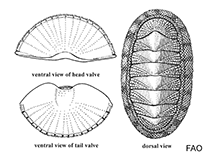Chiton tuberculatus Linnaeus, 1758
West Indian green chitonWarning: DOMDocument::load(): SSL operation failed with code 1. OpenSSL Error messages: error:140770FC:SSL routines:SSL23_GET_SERVER_HELLO:unknown protocol in C:\Apache24\htdocs\includes\SpeciesSummary.lib.php on line 1236
Warning: DOMDocument::load(): Failed to enable crypto in C:\Apache24\htdocs\includes\SpeciesSummary.lib.php on line 1236
Warning: DOMDocument::load(https://sealifebase.nrm.se/webservice/AquaMaps/getAMap.php?genus=Chiton&species=tuberculatus): failed to open stream: operation failed in C:\Apache24\htdocs\includes\SpeciesSummary.lib.php on line 1236
Warning: DOMDocument::load(): I/O warning : failed to load external entity "https://sealifebase.nrm.se/webservice/AquaMaps/getAMap.php?genus=Chiton&species=tuberculatus" in C:\Apache24\htdocs\includes\SpeciesSummary.lib.php on line 1236
muatnaik fotos/gambar
imej Google | No image available for this species;
drawing shows typical species in Chitonidae.
imej Google | No image available for this species;
drawing shows typical species in Chitonidae.
Classification / Names Common names | Synonyms | CoL | ITIS | WoRMS
| Chitonida | Chitonidae
Environment: milieu / climate zone / depth range / distribution range Ekologi
; kisaran kedalaman 0 - 4 m (Ref. 2022). Tropical
Penyebaran Negara-negara | Daerah-daerah FAO | Ecosystems | Kemunculan | Introduksi
Western Central Atlantic: USA, Colombia, Bermuda, Mexico, Venezuela and the West Indies.
Length at first maturity / Size / Weight / umur
Maturity: Lm ? range ? - ? cm Max length : 7.6 cm TL jantan/; (Ref. 281)
deskripsi pendek Morfologi
Valve color: Dull grayish green or greenish brown; Some valves, dark-brown arrow-shaped patch on the dorsal ridge. Lateral areas: Five irregular, radiating cords. Central areas: Smooth at the top and eight to nine strong, wavy, longitudinal ribs on the sides. Girdle color: Alternating zones of whitish, green or black. Scales: Appear to be slightly higher than broad (Ref. 281).
Epibiotic (Ref. 110502). Very common under rocks, in the zone between tides (Ref. 292); intertidal to shallow subtidal (Ref. 289); intertidal and spray zones of rocky shores (Ref. 2022).
Life cycle and mating behavior Kematangan | Reproduksi, perkembang biakan | Pemijahan | telur-telur | Fecundity | Larva
Members of the class Polyplacophora are mostly gonochoric. Life cycle: Eggs hatch into lecitotrophic planktonic trocophore larvae (no veliger stage) which later metamorphose and settle on the bottom as young adults.
rujukan utama
Acuan | Koordinator | mitra
Burghardt, G. and L. Burghardt. 2006. (Ref. 281)
Status IUCN Red List (Ref. 130435)
status CITES (Ref. 108899)
Not Evaluated
CMS (Ref. 116361)
Not Evaluated
ancaman kepada manusia
penggunaan manusia
| FishSource |
Alat, peralatan
informasi lanjut
Nama-nama umum
Sinonim (persamaan)
Pemangsa
Reproduksi, perkembang biakan
Kematangan
Pemijahan
Fecundity
telur-telur
pekembangan telor
Sinonim (persamaan)
Pemangsa
Reproduksi, perkembang biakan
Kematangan
Pemijahan
Fecundity
telur-telur
pekembangan telor
Sumber internet
BHL | BOLD Systems | CISTI | DiscoverLife | FAO(Publication : search) | Fishipedia | GenBank (genom, Nukleotida) | GloBI | Gomexsi | Google Books | Google Scholar | Google | PubMed | Tree of Life | Wikipedia (pergi, Cari) | Zoological Record
Estimates based on models
Preferred temperature
(Ref. 115969): 25.8 - 28.3, mean 27.5 (based on 436 cells).
kategori harga
(Ref. 80766):
Unknown.



